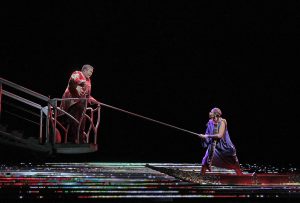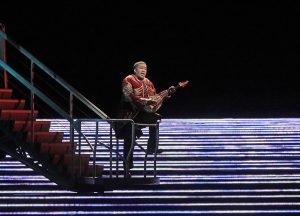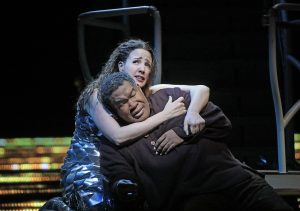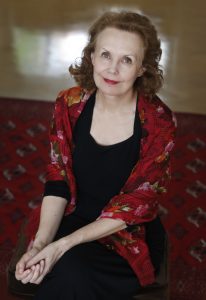The Metropolitan Opera’s production of L’Amour de Loin, by Finnish composer Kaija Saariaho, shines on the most trailblazing composer of the 21st century. It has been a limelight month for Saariaho in New York. Ensembles from the New York Philharmonic to educational institutions such as the Mannes School of Music have given Saariaho’s music a highlight in their programming calendar. These dedicated performances together with the house premiere of L’Amour de Loin at The Metropolitan Opera have not only addressed Saariaho’s stellar status but have inserted a post script on the position of female artists in opera. While Saariaho frequently stresses that she does not consider herself as a “woman composer,” nor alludes to her composition in terms of her gender, the weight of the moment cannot be dismissed.
The Met’s presentation of L’Amour de Loin must unequivocally be recorded as a significant event in the history of the company for the reasons that the staging marks the first production of an opera by female composer for 113 years, and for the second significance, that the production’s conductor, Susanna Mälkki represents the fourth woman in The Met’s history to take the podium. The sidebar here is that gender parity issues have been little addressed in opera performance in America and more pointedly at The Met. The significance of the Saariaho oversight is two fold. Firstly, the omission must be underscored as a prescient call to reconsider further repertoire decisions and to accelerate the contributions of advocacy organizations. Secondly, The Met exercised a noted delay in presenting L’Amour de Loin. Since its auspicious premiere at the 2000 Salzburg Festival the opera had achieved global, sustaining success with over ten productions from London to Sante Fe.
The consequences of the historical occasion stands alone and apart from the resounding achievement of the opera itself and this production.

Eric Owens as Jaufré Rudel and Tamara Mumford as the Pilgrim in Kaija Saariaho’s L’Amour de Loin. Photo by Ken Howard/Metropolitan Opera
L’Amour de Loin is based on the true life of the 12th-century troubadour Prince of Blaye, Jaufré Rudel. Through a pilgrim, Jaufré learns of the beauty of Clémence, the Countess of Tripoli. One part fairytale and one part mystical legend, L’Amour de Loin is an exploration of the purity of love. In his quest to meet his beloved, Jaufré take a trans-continental voyage by sea, offering the troubadour an opportunity to sing his ballads of devotion in the form of odes contemplating whether the stainless quality of love from afar is tainted by the physical encounter. The French libretto by Lebanese-born novelist Amin Maalouf interprets the tale with poetic simplicity. Maalouf also recalls excerpts from the seven extant poems of Rudel, providing the opera with an ancient echo.

Eric Owens as Jaufré Rudel in Kaija Saariaho’s L’Amour de Loin. Photo by Ken Howard/Metropolitan Opera
Saariaho’s score is color driven. She develops a prismatic language for her harmonic scheme and her apotheosis is not a search for the highest note of drama but a search for a climactic synthesis between language and music. The musical material is divided into three parts with dedicated, concise motifs distributed amongst the three protagonists. For instance, the arrival of the pilgrim is heralded by descending flute lines, while the entrances of the lovers are ushered with carpets of microtonal harmonies orchestrated with strings. The score achieves ephemeral beauty and sustaining drama throughout the five acts with a deft touch of seemingly transitory yet deeply connected musical statements.
L’Amour de Loin is essentially a series of monologues of internal contemplations that are interspersed with duets and chorus commentary. The success of this psychological drama relies on a cast with extraordinary vocal, musical and dramatic abilities. In this production, the opera has been exceptionally served. The roles of Jaufré (Eric Owens), Clémence (Susanna Phillips), and The Pilgrim (Tamara Mumford) demand a particular virtuosity, summoning skills outside the realm of traditional opera. The roles require the singer to communicate sustained passion, tension, and internal reflection across two hours. The singers must bring baroque ornamentation, vocal agility, and color to achieve the synesthetic qualities that Saariaho demands in an oratorio-like style. Each soloist delivered with distinction.

Eric Owens as Jaufré Rudel and Susanna Phillips as Clémence in Kaija Saariaho’s L’Amour de Loin. Photo by Ken Howard/Metropolitan Opera
The mono-dramatic nature and the skeletal narrative of the work offer challenges for the production. Robert Lepage’s vision answers the puzzle with a kinetic apparatus of animated stage machinery and lights. The illusion of the sea begins with a raked stage of over 28,000 LED lights that are choreographed in symmetry to emotional states of being. Together with lighting designer Kevin Adams and lightscape image designer Lionel Arnould, Lepage reflects the prismatic language of the score. The metaphoric sea of lights, respond in wave-like trances reflecting at once the glints of the sun and moon on the sea, pronouncements of hope and darkness, and psychological states that temper from joy to despair. The multi-purpose staircase with its heaven and earth symbolism, models as both a castle and fortress, and serves as a further metaphor for the chasm between the idealized and the real. Lepage plays with distance and perspective not only with the character’s relationship to their quest and to each other, but transfers a felt perspective to the audience. In the first half we feel removed and isolated, as if we too cannot achieve this love. By the final acts, the earth-bound reality of Jaufré’s death and his inability to succeed in his quest are brought to us through the immediacy of the downstage setting.
Conductor Susanna Mälkki presides over the score with comprehensive detail ensuring at all times that the emblematic motifs find their path and that the hues of harmonic color dominate. The warm applause and standing ovation stated the evening’s success but the warmest cheers were heard when Mälkki embraced Saariaho at the curtain call – a first at The Metropolitan Opera.
















